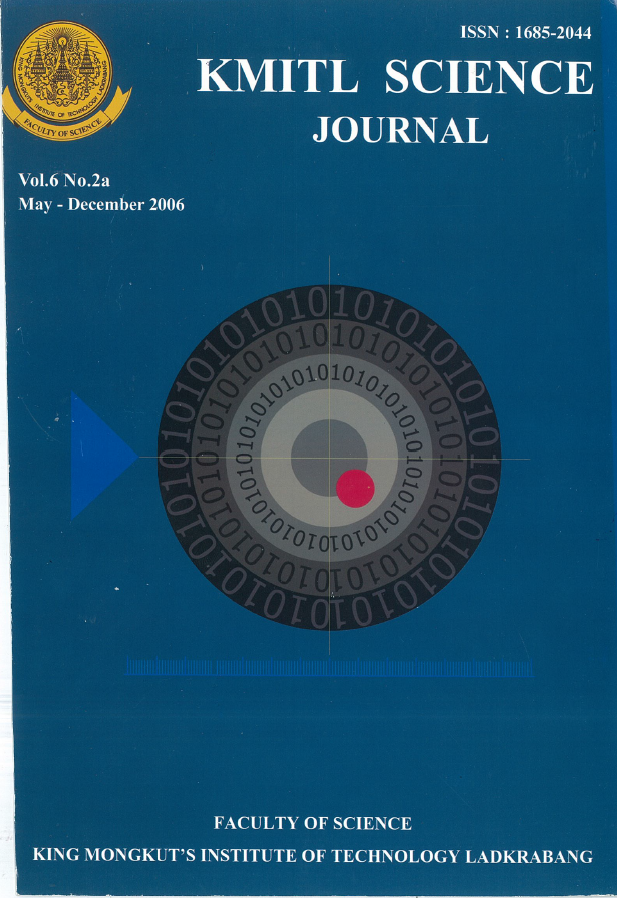Determining Number of Input Nodes of Recurrent Neural Networks for River Flow Forecasting
Main Article Content
Abstract
In recent years, artificial neural networks have been applied in many fields. Reportedly, the structure of networks seriously affects the performance of the network model. A scheme for river flow forecasting with a recurrent neural network has been proposed in this paper which consists of the phase that determines of input patterns. Autocorrelation analysis is used to identify the number of input nodes of time series for training. The calculated number of neurons for an input layer is then used to construct the fully recurrent neural network forecaster. Computer simulations are presented to show the effectiveness of the scheme. The results obtained show that autocorrelation and cross correlation analysis can be used to determine the number of input nodes. In terms of the performance statistics, an online training algorithm for fully recurrent neural networks has high forecasting accuracy.
Keywords: Autocorrelation analysis, crosscorrelation analysis, network architecture, fully recurrent neural networks, number of input nodes, efficiency index, computational time.
Corresponding author: E-mail: suwarin@rmut.ac.th, suwat@rmut.ac.th
Article Details
Copyright Transfer Statement
The copyright of this article is transferred to Current Applied Science and Technology journal with effect if and when the article is accepted for publication. The copyright transfer covers the exclusive right to reproduce and distribute the article, including reprints, translations, photographic reproductions, electronic form (offline, online) or any other reproductions of similar nature.
The author warrants that this contribution is original and that he/she has full power to make this grant. The author signs for and accepts responsibility for releasing this material on behalf of any and all co-authors.
Here is the link for download: Copyright transfer form.pdf
References
[2] Cybenko, G. 1989 Approximation by Superpositions of Sigmoidal Function, Mathe-matical Control System. 2, 303-314.
[3] Luukkonen, R., Saikkonen, P. and Terasirta, T. 1988 Testing Linearity in Univariate Time Series Models, Scandinavian Journal of Statistics 15, 161-175.
[4] Saikkonen, P. and Luukonen, R. 1988 Lagrange Multiplier Tests for Testing Non-Linearities in Time Series Models, Scandinavian Journal of Statistics 15, 55-68.
[5] Chan, W.S. and Tong, H. 1986 On Tests for Non-Linearity in Time Series Analysis, Journal of Forecasting 5, 217-228.
[6] Hinich, M.J. 1982 Testing for Gaussianity and Linearity of a Stationary Time Series, Journal of Time Series Analysis. 3, 169-176.
[7] Jarrett, J. 1991 Business Forecasting Methods. Basil Black Well.
[8] William, R and Zipser, D, 1989 A Learning Algorithm for Continually Running Fully Recurrent Neural Networks, Neural Computation, 1, 270.
[9] Yamamoto, Y. and Nikiforuk, P.N. 1999 A Learning Algorithm for Recurrent Neural Networks and Its Application to Nonlinear Identification, Proceeding of the 1999 IEEE International Symposium on Computer Aided Control System Design, Hawaii. Pp. 551-556.
[10] Atiya, A.F. El-Shoura, S.M. and Shaheen, S.I. 1999 Comparison Between Neural Network Forecasting Techniques-Case Study : River Flow Forecasting, IEEE Transaction on Neural Networks, 10(2). 402-409.
[11] Lin, F. Tu, X.H. Gregos, S. and Irons, R. 1995 Time Series Forecasting with Neural Networks, Complexity International, 2, 1-12.
[12] Danh, N.T. Phien, H.N. and Gupta, A.D. 1999 Neural Network Models for River Flow Forecasting. Water SA, 25(1), 33-39
[13] Nash, J.E. and Sutchffee, J.V. 1970 River Flow Forecasting Through Conceptual Models, Journal of Hydrology, 10, 282-290.


